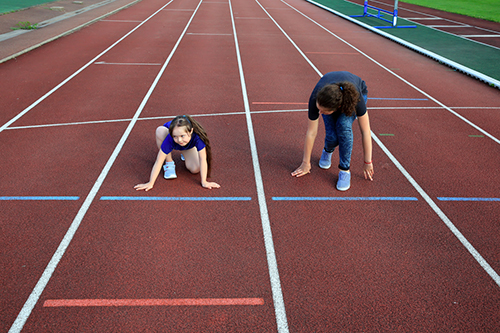Sports are a great activity for youth, and there’s an abundance of research that supports the positive impact they have on a child’s development—from physical to cognitive. For starters, those who participate in high school sports and remain physically active are less likely to experience obesity, have a lower incidence of heart disease, stroke or even cancer. Statistics also show that high school students who participate in sports are far less likely to drop out of school. In fact, participation in high school sports actually has been shown to deliver consistently higher grades and athletes are 15% more likely to attend college.1
However, as with most activities, there are risk. Injuries during sports-related events and practices may seem inevitable but there are steps that parents can take to help prevent and reduce the risk for their child. Here are the top five things you should know if your child currently plays or is considering playing sports:
The Top 5 Things Parents Should Know About Sports
5. The risk of injury is high. Nine out of 10 student athletes report some sort of sports-related injury in their athletic careers, and more than 60 percent of these injuries occur during practice.2,3 Even worse, there have been more than 300 sports-related fatalities since 2008.4
Parent tip: Have your child screened for underlying risk factors such as heart or blood conditions. A pre- participation physical examination (PPE) can reveal severe problems that might put your child in danger during strenuous physical activity.
4. Concussions are serious. Concussions are no longer thought of as simple “bumps on the head” or “bell-ringers”; they are traumatic injuries to the brain that can impact a child’s long-term health, memory and learning.
Parent tip: Know the signs and symptoms of a concussion. Ensure that your child has a baseline test at the start of each season and that your school has a return-to-play program in place should your child experience a concussion. Be sure your child is cleared by a health care professional with concussion training such as an athletic trainer or sports medicine physician, before returning to play.
3. More than half of student athletes have played while injured. Many student athletes play through injuries because they don’t want to let their teammates down or feel it is too important of a game. 2
Parent tip: Remind your child that no game is so important that it’s worth endangering his or her well-being. Encourage your athlete to take the appropriate amount of time for recovery. Returning to play before she is ready will only increase the risk of re-injury. Foster a healthy environment and encourage communication. Let your child know that it is ok to speak up when he or she is hurt.
2. The benefits outweigh the risks. Nearly 20% of children in our nation are obese and physical activity amongst youth is rapidly declining.5 Obesity, which often begins in childhood, can cause reduced life expectancy, heart disease, stroke, cancer and diabetes.
Aside from the obvious physical benefits, children who play sports learn important life skills like dedication, teamwork and good sportsmanship.
Parent tip: Encourage physical activity by keeping sports fun! Keep the game in perspective by focusing on individual effort rather than winning or losing. Give positive feedback and cheer your child on. Allow your child to try different sports or activities that interest her.
Most of all, model healthy behaviors for them. A child who sees his parents active and eating healthy will have good examples to follow and will be more likely to do the same.
1. You can help reduce the risk of sports-related injury. As a parent you are your child’s primary advocate. Stay up-to-date with sports safety knowledge and tips to keep your athlete healthy, active and safe. Use your voice to improve sports safety in your child’s school or youth league.
Parent tip: Find out if your child’s school has proper sports safety measures in place. Do they have and regularly practice an emergency action plan? Do they have a working automated external defibrillator (AED) at all sporting venues? Are coaches CPR and AED-trained in case of an emergency? Does your school have an athletic trainer (AT)? Does the AT provide care at practices and games?
Work with your child’s school and youth leagues to help improve safety. Don’t be afraid to ask questions. Remember, you are your child’s number one fan and advocate for safety.
Resources
The National Athletic Trainers’ Association (NATA) recently launched At Your Own Risk, a public awareness campaign designed to educate parents, schools administrators, student athletes and legislators on safety issues in work, life and sport. Visit AtYourOwnRisk.org to find key resources to help you improve safety in your school:
- Take the interactive quiz to assess the risk in your school.
- Learn more about key health and youth sports related issues with our infographics.
- Discover who athletic trainers are and how they can help improve safety in your school.
- See which sports safety policies your state has in place on our Sports Safety Map.
NATA has collaborated with the American Heart Association and the National Football League to provide sports safety education for parents and students through the Back to Sports program. Learn more about hosting this program at your school.
Scott Sailor, EdD, ATC is the President of the National Athletic Trainers Association (NATA ).
References
1. Facts: Sports Activity and Children. (n.d.). Retrieved September 29, 2015, from http://www.aspenprojectplay.org/the-facts
2. SafeKids Worldwide: Changing the Culture of Youth Sports Report – 2014 http://www.safekids. org/research-report/research-report-changing-culture-youth-sports-august-2014
3. Centers for Disease Control and Prevention. Web-based Injury Statistics Query and Reporting System (WISQARS) Cost of Injury Reports. Available at: http://wisqars.cdc.gov:8080/costT/.
4 National Athletic Trainers’ Association. (unpublished media review)
5 Flegal, K.M., Carroll, M.D., Ogden, C.L., & Curtin, L.R. (2010). Prevalence and trends in obesity among U.S. adults, 1999-2008. Journal of the American Medical Association, 303, 235-241





